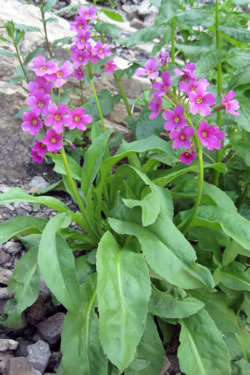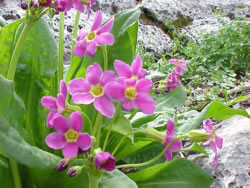Plant of the Week
 Range map of Primula parryi. States are colored green where the species may be found.
Range map of Primula parryi. States are colored green where the species may be found.
 Parry’s Primrose (Primula parryi).
Parry’s Primrose (Primula parryi).
 Parry’s Primrose (Primula parryi) at Bloomington Lake, Caribou-Targhee National Forest.
Parry’s Primrose (Primula parryi) at Bloomington Lake, Caribou-Targhee National Forest.
Parry’s Primrose (Primula parryi)
By Rose Lehman
Parry's primrose (Primula parryi) is a member of the primrose family (Primulaceae) and is the largest and showiest of the North America primroses. It is 9 to 20 inches (15 to 50 centimeters) tall in clumped rosettes (usually) with broadly lance-shaped to egg-shaped leathery leaves. It is the most common Primula species in the western United States.
Its inflorescences with 5 to 25 magenta flowers on a long stem and brilliant green foliage is a rewarding treat to high country hikers that venture in the summer to the edge of melting snow or other moist areas along streams, springs and wet meadows, 8,800 to 13,800 feet (2700 to 4200 meters) above sea level.
Parry's primrose other unique trait for North America primroses contrasts unpleasantly to its beauty; the odor of the plant is rankly aromatic. The primrose's skunky smell can last years as a pressed, dry plant.
The plants name Primula parryi honors Charles C. Parry, an English physician of the 1800s. For over 40 years, he collected many plants and was the first botanist for the United State Department of Agriculture, a post that he held for three years. He was a well-respected botanist. As quoted in the Botanical Gazette upon his death in 1890, "Our western flora can hardly be touched at any point without encountering the name of Parry, our oldest and most distinguished botanical explorer. Hundreds of new plants were brought to light by him."
The Primula name for the genus comes from Latin primus, first; and; ulus, tiny, alluding to early spring blooming.
For More Information
- PLANTS Profile - Primula parryi , Parry's primrose
- Flora of North America: Primula parryi
- Botanical Gazette Volume 15, No. 3, March 1890
- Intermountain Region: You Are There! Hike the Highline Trail
- Rocky Mountain Region Viewing Area: Boreas Pass
- Southwestern Region Viewing Area: Valle Vidal
- Wildflower Coloring Book: Wildflowers of the Colorado Mountain Tops, Parry's Primula, page 30 (PDF, 2.8 MB)



